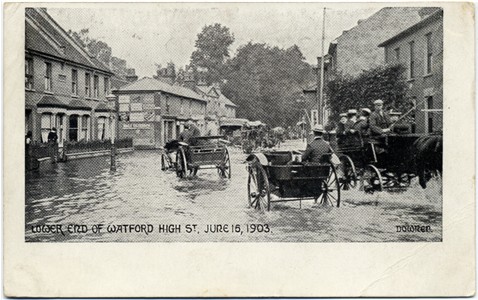|
|
The River Colne near Watford
|
|
The river Colne rises in two streams, one at Colney Heath, near Hatfield, and the other between Elstree and Barnet; it flows southwest in a winding course through Herts to Rickmansworth, and leaves a few miles south of that place. The area of its basin in Herts is 200 square miles. Looking at that part of the valley of the Colne in the parish of Watford, one is led to the conclusion that in the olden times this valley was one marsh or swamp, and that the artificial banks, which now hold the stream and direct its course through the centre of the valley, were made to concentrate the water for the use of the neighbouring mills.
Some time ago, when excavating at the 'Watford Gas Works, the workmen found a number of bones, which were submitted to Dr. Brett for examination, who pronounced some to be human, and others those of a horse and red deer; they were afterwards seen by a professor of anatomy, who fully confirmed Dr. Brett's opinion thereon. The theory this circumstance introduces is, that the ford once at the bottom of the town was much wider than the present stream, and that some unfortunate man on horseback attempted to cross it and both were lost in the swamp; and that the other bones were those of one of the wild deer with which the woods of this county abounded centuries ago.
Fifty years ago the Colne at Watford abounded with fish, including fine trout, pike, and perch, and for many years no restriction existed as to fishing, and this sport was indulged in so extensively that the river was nearly bereft of its finny occupants. Some years ago, however, Mr. Jonathan King and others concerned stopped the angling to a great extent, and the quantity of fish increased. At various times Mr. King put a quantity of Neuchâtel trout in the stream, and some fine ones have been occasionally caught - one in April, 1883, by Mr. C. H. Thomas, of Colnebrook, weighing nine pounds and three-quarters. In 1856, when there were plenty of fish in the Colne, Mr. King netted, at Wiggen Hall, fifty-four pounds of trout in one day. At one time the canal in Cassiobury Park was dragged periodically with a net, and a large quantity of fine fish caught, the best of which were sent as presents to some of the inhabitants of Watford. Mr. Mead ha stated that the largest quantity of eels caught on anyone day at Watford Mills was about three hundredweight. Fish hatching was carried on at one time by Mr. Hibbert, Lord Essex, and Mr. J King.
About thirty-five years ago there was a public-house at the bottom of Water Lane, close to the river, which when closed was turned into the two cottages now there. The sign was the "Fighting Cocks," a very apropos sign, as the brutal pastime of cock-fighting was carried on there at one time. During the time of the last occupant, Mrs. Lucy Deacon, it was a pleasure-boat station, where one could hire a boat and enjoy a row up the river as far as Bushey Mill Bridge; the charge was one shilling per hour, and the person or party hiring the boat was required to leave half-a-crown with the landlady as a security against any loss she might sustain by damage done to her boat. The house and premises were generally crowded on Sunday afternoons and evenings, and not infrequently a spill into the water occurred when the boat was occupied by youth who had indulged freely in drinking before they had started on their voyage up the Colne. The bridge over the river, and also that over the ditch beyond, were widened by the late Mr. Majoribanks; he also desired to widen the bridge over the Rickmansworth Railway in Water Lane, but the company's terms were not acceptable to him, and consequently an improvement so desirable was not carried out.
The Colne has always been a favourite stream for bathing, and some years ago private boxes were erected by Mr. Geo. Downer, with the permission of Mr. Whittingstall, then the owner of the adjoining land. These boxes however, were removed, and some more suitable were erected by the Local Board on the other side of the railway viaduct, an arrangement having been entered into with the London and North-Western Railway Company for a long tenure of the land on which the boxes now stand.
 The Flood - Watford High Street, June 1903 Published by Downer |
The lower end of the High Street is on what would
earlier have been water meadows and flooding was a problem.
For more information of flooding see HAMPSON, Watford, late 19th Century |
The Valley of the Colne from Bushey Mill to Hamper Mill is much flooded each year during the winter and spring months. A few years ago a sudden thaw, with rain, after a deep fall of snow, flooded the meadows, and before the water subsided a severe frost set in and a thick sheet of ice was formed all over them beyond the Loates Lane Arch. When the water went down, this sheet of ice was left on the grass, forming a splendid skating ground, on which thousands indulged in the healthful pastime of skating; tents were erected in which ladies put on their skates, and articles of dress were left. Each night the ice was lit with torches, and the scene, as viewed from the banks of the railway, was very grand. This continued but a short time, as the uneven nature of the ground under the ice caused it to crack and become dangerous after it had been in use a few days.
Page created August 2007